Use of Heavy Metal Content and Modified Water Quality Index to Assess Groundwater Quality in a Semiarid Area
Abstract
1. Introduction
2. Materials and Methods
2.1. Study Area
2.2. Sample Collection and Analytical Procedure
2.3. Water Quality Index (WQI) and Entropy Weight Method
2.4. Evaluation of Groundwater Quality for Irrigation Purposes
- The Sodium Adsorption Ratio (SAR) was calculated by [44]:
- The sodium percentage is computed with respect to relative proportions of cations present in water using:
- Doneen [45] classified irrigated water based on permeability index (PI) according to:
- Total hardness (TH) was calculated by [46]:
- Magnesium Ratio (MR) was calculated by [46]:
2.5. Heavy Metal Pollution Indices
2.5.1. Modified Heavy Metal Pollution Index (m-HPI)
2.5.2. Heavy Metal Evaluation Index (HEI)
2.5.3. Nemerow Index (NeI)
2.5.4. Ecological Risks of Heavy Metals in Groundwater
3. Results and Discussions
3.1. Statistical Analysis
3.2. Suitability of Groundwater for Drinking Use
Entropy Weighted Water Quality Index (EWQI)
3.3. Suitability of Groundwater for Irrigation
3.3.1. The US Salinity Laboratory’s Diagram and Sodium Percentage (Na%)
3.3.2. Total Dissolved Solids (TDS)
3.3.3. Permeability Index (PI)
3.3.4. Total Hardness (TH)
3.3.5. Magnesium Ratio (MR)
3.4. Heavy Metal Pollution Assessment
4. Conclusions
Author Contributions
Funding
Acknowledgments
Conflicts of Interest
References
- Rao, K.N.; Latha, P.S. Groundwater quality assessment using water quality index with a special focus on vulnerable tribal region of Eastern Ghats hard rock terrain, Southern India. Arab. J. Geosci. 2019, 12, 1–16. [Google Scholar] [CrossRef]
- Maharjan, A.K.; Kamei, T.; Amatya, I.M.; Mori, K.; Kazama, F.; Toyama, T. Ammonium-Nitrogen (NH4+-N) Removal from Groundwater by a Dropping Nitrification Reactor: Characterization of NH4+-N Transformation and Bacterial Community in the Reactor. Water 2020, 12, 599. [Google Scholar] [CrossRef]
- Nurtazin, S.; Pueppke, S.; Ospan, T.; Mukhitdinov, A.; Elebessov, T. Quality of Drinking Water in the Balkhash District of Kazakhstan’s Almaty Region. Water 2020, 12, 392. [Google Scholar] [CrossRef]
- Sahoo, M.M.; Swain, J.B. Modified heavy metal Pollution index (m-HPI) for surface water Quality in river basins, India. Environ. Sci. Pollut. Res. 2020. [Google Scholar] [CrossRef]
- Kim, S.; Eom, S.; Kim, H.-J.; Lee, J.J.; Choi, G.; Choi, S.; Kim, S.; Kim, S.Y.; Cho, G.; Kim, Y.D.; et al. Association between maternal exposure to major phthalates, heavy metals, and persistent organic pollutants, and the neurodevelopmental performances of their children at 1 to 2 years of age- CHECK cohort study. Sci. Total Environ. 2018, 624, 377–384. [Google Scholar] [CrossRef]
- Fetter, C.W.; Boving, T.; Kreamer, D. Contaminant Hydrogeology, 3rd ed.; Waveland Press, Inc.: Long Grove, IL, USA, 2018; ISBN 9781478632795. [Google Scholar]
- Wołowiec, M.; Komorowska-kaufman, M.; Pruss, A.; Rzepa, G.; Bajda, T. Removal of heavy metals and metalloids from water using drinking water treatment residuals as adsorbents: A review. Minerals 2019, 9, 487. [Google Scholar] [CrossRef]
- Joseph, L.; Jun, B.-M.; Flora, J.R.V.; Park, C.M.; Yoon, Y. Removal of heavy metals from water sources in the developing world using low-cost materials: A review. Chemosphere 2019, 229, 142–159. [Google Scholar] [CrossRef]
- Liosis, C.; Karvelas, E.G.; Karakasidis, T.; Sarris, I.E. Numerical study of magnetic particles mixing in wastewater under an external magnetic field. Water Supply Res. Technol. 2020. [Google Scholar] [CrossRef]
- Karvelas, E.; Liosis, C.; Benos, L.; Karakasidis, T.; Sarris, I. Micromixing efficiency of particles in heavy metal removal processes under various inlet conditions. Water 2019, 11, 1135. [Google Scholar] [CrossRef]
- Karvelas, E.G.; Lampropoulos, N.K.; Karakasidis, T.E.; Sarris, I.E. A computational tool for the estimation of the optimum gradient magnetic field for the magnetic driving of the spherical particles in the process of cleaning water. Desalin. Water Treat. 2017, 99, 27–33. [Google Scholar] [CrossRef]
- Ranieri, E.; Gorgoglione, A.; Montanaro, C.; Iacovelli, A.; Gikas, P. Removal capacity of BTEX and metals of constructed wetlands under the influence of hydraulic conductivity. Desalin. Water Treat. 2015, 56, 1256–1263. [Google Scholar] [CrossRef]
- Bodrud-Doza, M.; Islam, A.R.M.T.; Ahmed, F.; Das, S.; Saha, N.; Rahman, M.S. Characterization of groundwater quality using water evaluation indices, multivariate statistics and geostatistics in central Bangladesh. Water Sci. 2016, 30, 19–40. [Google Scholar] [CrossRef]
- Gulgundi, M.S.; Shetty, A. Groundwater quality assessment of urban Bengaluru using multivariate statistical techniques. Appl. Water Sci. 2018, 8, 43. [Google Scholar] [CrossRef]
- Chen, J.; Huang, Q.; Lin, Y.; Fang, Y.; Qian, H.; Liu, R.; Ma, H. Hydrogeochemical characteristics and quality assessment of groundwater in an irrigated region, Northwest China. Water 2019, 11, 96. [Google Scholar] [CrossRef]
- Ndoye, S.; Fontaine, C.; Gaye, C.B.; Razack, M. Groundwater quality and suitability for different uses in the Saloum area of Senegal. Water 2018, 10, 1837. [Google Scholar] [CrossRef]
- Zhang, X.; Hu, B.; Wang, P.; Chen, J.; Yang, L.; Xiao, K.; Zhang, X. Hydrogeochemical evolution and heavy metal contamination in groundwater of a reclaimed land on Zhoushan Island. Water 2018, 10, 316. [Google Scholar] [CrossRef]
- Wang, H.; Nie, L.; Xu, Y.; Du, C.; Zhang, T.; Wang, Y. Effects of highway-related pollutant on the qroundwater quality of turfy swamps in the Changbai Mountain Area. Int. J. Environ. Res. Public Health 2018, 15, 1652. [Google Scholar] [CrossRef] [PubMed]
- Withanachchi, S.; Ghambashidze, G.; Kunchulia, I.; Urushadze, T.; Ploeger, A. Water quality in surface water: A preliminary assessment of heavy metal contamination of the Mashavera River, Georgia. Int. J. Environ. Res. Public Health 2018, 15, 621. [Google Scholar] [CrossRef]
- Reyes-Toscano, C.A.; Alfaro-Cuevas-Villanueva, R.; Cortés-Martínez, R.; Morton-Bermea, O.; Hernández-Álvarez, E.; Buenrostro-Delgado, O.; Ávila-Olivera, J.A. Hydrogeochemical characteristics and assessment of drinking water quality in the urban area of Zamora, Mexico. Water 2020, 12, 556. [Google Scholar] [CrossRef]
- Liang, B.; Han, G.; Liu, M.; Yang, K.; Li, X.; Liu, J. Distribution, sources, and water quality assessment of dissolved heavy metals in the Jiulongjiang river water, Southeast China. Int. J. Environ. Res. Public Health 2018, 15, 2752. [Google Scholar] [CrossRef]
- Amiri, V.; Rezaei, M.; Sohrabi, N. Groundwater quality assessment using entropy weighted water quality index (EWQI) in Lenjanat, Iran. Environ. Earth Sci. 2014, 72, 3479–3490. [Google Scholar] [CrossRef]
- Chaturvedi, A.; Bhattacharjee, S.; Mondal, G.C.; Kumar, V.; Singh, P.K.; Singh, A.K. Exploring new correlation between hazard index and heavy metal pollution index in groundwater. Ecol. Indic. 2019, 97, 239–246. [Google Scholar] [CrossRef]
- Rezaei, A.; Hassani, H.; Hassani, S.; Jabbari, N.; Fard Mousavi, S.B.; Rezaei, S. Evaluation of groundwater quality and heavy metal pollution indices in Bazman basin, southeastern Iran. Groundw. Sustain. Dev. 2019, 9, 100245. [Google Scholar] [CrossRef]
- Mukherjee, I.; Singh, U.K.; Singh, R.P.; Kumari, D.; Jha, P.K.; Mehta, P. Characterization of heavy metal pollution in an anthropogenically and geologically influenced semi-arid region of east India and assessment of ecological and human health risks. Sci. Total Environ. 2020, 705, 135801. [Google Scholar] [CrossRef]
- Chaturvedi, A.; Bhattacharjee, S.; Singh, A.K.; Kumar, V. A new approach for indexing groundwater heavy metal pollution. Ecol. Indic. 2018, 87, 323–331. [Google Scholar] [CrossRef]
- Sawut, R.; Kasim, N.; Maihemuti, B.; Hu, L.; Abliz, A.; Abdujappar, A.; Kurban, M. Pollution characteristics and health risk assessment of heavy metals in the vegetable bases of northwest China. Sci. Total Environ. 2018, 642, 864–878. [Google Scholar] [CrossRef] [PubMed]
- Boateng, T.K.; Opoku, F.; Acquaah, S.O.; Akoto, O. Groundwater quality assessment using statistical approach and water quality index in Ejisu-Juaben Municipality, Ghana. Environ. Earth Sci. 2016, 75, 1–14. [Google Scholar] [CrossRef]
- Manikandan, S.; Chidambaram, S.; Prasanna, M.V.; Ganayat, R.R. Assessment of Heavy Metals Pollution and Stable Isotopic Signatures in Hard Rock Aquifers of Krishnagiri District, South India. Geosciences 2019, 9, 200. [Google Scholar] [CrossRef]
- Belkhiri, L.; Tiri, A.; Mouni, L. Assessment of Heavy Metals Contamination in Groundwater: A Case Study of the South of Setif Area, East Algeria. In Achievements and Challenges of Integrated River Basin Management; InTech: London, UK, 2018. [Google Scholar]
- Belkhiri, L.; Mouni, L.; Sheikhy Narany, T.; Tiri, A. Evaluation of potential health risk of heavy metals in groundwater using the integration of indicator kriging and multivariate statistical methods. Groundw. Sustain. Dev. 2017, 4, 12–22. [Google Scholar] [CrossRef]
- Rezaei, H.; Jafari, A.; Kamarehie, B.; Fakhri, Y.; Ghaderpoury, A.; Karami, M.A.; Ghaderpoori, M.; Shams, M.; Bidarpoor, F.; Salimi, M. Health-risk assessment related to the fluoride, nitrate, and nitrite in the drinking water in the Sanandaj, Kurdistan County, Iran. Hum. Ecol. Risk Assess. Int. J. 2019, 25, 1242–1250. [Google Scholar] [CrossRef]
- Azizi, F.; Mohammadzadeh, H. Aquifer vulnerability and evaluation of groundwater quality spatial variations in GhachsaranEmamzadehJaafar plain using DRASTIC model and GWQI index. Water Eng. 2012, 5, 1–14. [Google Scholar]
- Liu, F.; Zhao, Z.; Yang, L.; Ma, Y.; Li, B.; Gong, L.; Liu, H. Phreatic Water Quality Assessment and Associated Hydrogeochemical Processes in an Irrigated Region Along the Upper Yellow River, Northwestern China. Water 2020, 12, 463. [Google Scholar] [CrossRef]
- Akter, T.; Jhohura, F.T.; Akter, F.; Chowdhury, T.R.; Mistry, S.K.; Dey, D.; Barua, M.K.; Islam, M.A.; Rahman, M. Water Quality Index for measuring drinking water quality in rural Bangladesh: A cross-sectional study. J. Heal. Popul. Nutr. 2016, 35, 1–12. [Google Scholar] [CrossRef]
- WHO. Guidelines for Drinking-Water Quality, 4th ed. Available online: http://www.who.int/water_sanitation_health/publications/dwq_guidelines/en/# (accessed on 30 March 2016).
- Olasoji, S.; Oyewole, N.; Abiola, B.; Edokpayi, J. Water quality assessment of surface and groundwater sources Using a water quality index method: A case study of a Peri-Urban Town in Southwest, Nigeria. Environments 2019, 6, 23. [Google Scholar] [CrossRef]
- Peiyue, L.I.; Jianhua, W.U.; Hui, Q. Groundwater quality assessment based on entropy weighted osculating value method. Int. J. Environ. Sci. 2010, 1, 621–630. [Google Scholar]
- Shannon, C.E. A Mathematical Theory of Communication. Bell Syst. Tech. J. 1948, 27, 379–423. [Google Scholar] [CrossRef]
- Kawachi, T.; Maruyama, T.; Singh, V.P. Rainfall entropy for delineation of water resources zones in Japan. J. Hydrol. 2001, 246, 36–44. [Google Scholar] [CrossRef]
- Ozkul, S.; Harmancioglu, N.B.; Singh, V.P. Entropy-based assessment of water quality monitoring networks. J. Hydrol. Eng. 2000, 5, 90–100. [Google Scholar] [CrossRef]
- Li, H.; Wang, W.; Fan, L.; Li, Q.; Chen, X. A novel hybrid MCDM model for machine tool selection using fuzzy DEMATEL, entropy weighting and later defuzzification VIKOR. Appl. Soft Comput. 2020, 91, 1–14. [Google Scholar] [CrossRef]
- Vasanthavigar, M.; Srinivasamoorthy, K.; Vijayaragavan, K.; Rajiv Ganthi, R.; Chidambaram, S.; Anandhan, P.; Manivannan, R.; Vasudevan, S. Application of water quality index for groundwater quality assessment: Thirumanimuttar sub-basin, Tamilnadu, India. Environ. Monit. Assess 2010, 171, 595–609. [Google Scholar] [CrossRef]
- Richards, L.A. Diagnosis and Improvement of Saline and Alkali Soils; United States Department of Agriculture: Washington, DC, USA, 1954. [Google Scholar]
- Doneen, L. Notes on water quality in agriculture. In Water Science and Engineering Paper 4001; Department of Water Sciences and Engineering, University of California: Oakland, CA, USA, 1964. [Google Scholar]
- Raghunath, I.I.M. Groundwater, 2nd ed.; Wiley Eastern Ltd.: New Delhi, India, 1987. [Google Scholar]
- Sarath Prasanth, S.V.; Magesh, N.S.; Jitheshlal, K.V.; Chandrasekar, N.; Gangadhar, K. Evaluation of groundwater quality and its suitability for drinking and agricultural use in the coastal stretch of Alappuzha District, Kerala, India. Appl. Water Sci. 2012, 2, 165–175. [Google Scholar] [CrossRef]
- Liu, S.; Zhang, Y.; Bi, S.; Zhang, X.; Li, X.; Lin, M.; Hu, G. Heavy metals distribution and environmental quality assessment for sediments off the southern coast of the Shandong Peninsula, China. Mar. Pollut. Bull. 2015, 100, 483–488. [Google Scholar] [CrossRef] [PubMed]
- Vu, C.T.; Lin, C.; Shern, C.-C.; Yeh, G.; Le, V.G.; Tran, H.T. Contamination, ecological risk and source apportionment of heavy metals in sediments and water of a contaminated river in Taiwan. Ecol. Indic. 2017, 82, 32–42. [Google Scholar] [CrossRef]
- Sharifi, Z.; Hossaini, S.M.T.; Renella, G. Risk assessment for sediment and stream water polluted by heavy metals released by a municipal solid waste composting plant. J. Geochem. Explor. 2016, 169, 202–210. [Google Scholar] [CrossRef]
- Wen, X.; Lu, J.; Wu, J.; Lin, Y.; Luo, Y. Influence of coastal groundwater salinization on the distribution and risks of heavy metals. Sci. Total Environ. 2019, 652, 267–277. [Google Scholar] [CrossRef]
- Wang, N.; Wang, A.; Kong, L.; He, M. Calculation and application of Sb toxicity coefficient for potential ecological risk assessment. Sci. Total Environ. 2018, 610–611, 167–174. [Google Scholar] [CrossRef]
- Hakanson, L. An ecological risk index for aquatic pollution control.a sedimentological approach. Water Res. 1980, 14, 975–1001. [Google Scholar] [CrossRef]
- Bhardwaj, K.S.P.R. Water quality index and fractal dimension analysis of water parameters. J. Environ. Sci. Technol. 2013, 10, 151–164. [Google Scholar]
- Rabeiy, R.E. Assessment and modeling of groundwater quality using WQI and GIS in Upper Egypt area. Environ. Sci. Pollut. Res. 2018, 25, 30808–30817. [Google Scholar] [CrossRef]
- Gnanachandrasamy, G.; Dushiyanthan, C.; Jeyavel Rajakumar, T.; Zhou, Y. Assessment of hydrogeochemical characteristics of groundwater in the lower Vellar river basin: Using Geographical Information System (GIS) and Water Quality Index (WQI). Environ. Dev. Sustain. 2020, 22, 759–789. [Google Scholar] [CrossRef]
- Maskooni, E.K.; Kompanizare, M.; Afzali, S.F. Chemical assessment of dam water irrigation effects on groundwater qualities in Bigherd plain, Fars Province, Iran. Environ. Earth Sci. 2017, 76, 238. [Google Scholar] [CrossRef]
- Salifu, M.; Aidoo, F.; Hayford, M.S.; Adomako, D.; Asare, E. Evaluating the suitability of groundwater for irrigational purposes in some selected districts of the Upper West region of Ghana. Appl. Water Sci. 2015, 7, 653–662. [Google Scholar] [CrossRef]
- Ayers, R.; Westcott, D. Water Quality for Agriculture (No. 29); Food and Agriculture Organization of the United Nations: Rome, Italy, 1985. [Google Scholar]
- Schroeder, H.A. Relations between hardness of water and death rates from certain chronic and degenerative diseases in the United States. J. Chronic Dis. 1960, 12, 586–591. [Google Scholar] [CrossRef]
- Selvakumar, S.; Chandrasekar, N.; Kumar, G. Hydrogeochemical characteristics and groundwater contamination in the rapid urban development areas of Coimbatore, India. Water Resour. Ind. 2017, 17, 26–33. [Google Scholar] [CrossRef]
- Banerji, S.; Mitra, D. Geographical information system-based groundwater quality index assessment of northern part of Kolkata, India for drinking purpose. Geocarto Int. 2018, 6049, 1–16. [Google Scholar] [CrossRef]
- Chidambaram, S.; Bala Krishna Prasad, M.; Manivannan, R.; Karmegam, U.; Singaraja, C.; Anandhan, P.; Prasanna, M.V.; Manikandan, S. Environmental hydrogeochemistry and genesis of fluoride in groundwaters of Dindigul district, Tamilnadu (India). Environ. Earth Sci. 2013, 68, 333–342. [Google Scholar] [CrossRef]
- Lakshmanan, E.; Kannan, R. Major Ion Chemistry And Identification Of Hydrogeochemical Processes Of Ground Water In A Part Of Kancheepuram District; Tamil Nadu, India. Environ. Geosci. 2003, 10, 157–166. [Google Scholar] [CrossRef]
- Nazzal, Y.; Ahmed, I.; Al-Arifi, N.S.N.; Ghrefat, H.; Zaidi, F.K.; El-Waheidi, M.M.; Batayneh, A.; Zumlot, T. A pragmatic approach to study the groundwater quality suitability for domestic and agricultural usage, Saq aquifer, northwest of Saudi Arabia. Environ. Monit. Assess. 2014, 186, 4655–4667. [Google Scholar] [CrossRef]
- Szabolcs, I.; Darab, C. The influence of irrigation water of high sodium carbonate content of soils. In Proceedings of the 8th International Congress of ISSS, Trans, II, Bucharest, Romania, 31 August 1964. [Google Scholar]
- Raihan, F.; Alam, J.B. Assessment of groundwater quality in sunamganj of bangladesh. Iran. J. Environ. Heal. Sci. Eng. 2008, 5, 155–166. [Google Scholar]
- Boateng, T.K.; Opoku, F.; Acquaah, S.O.; Akoto, O. Pollution evaluation, sources and risk assessment of heavy metals in hand-dug wells from Ejisu-Juaben Municipality, Ghana. Environ. Syst. Res. 2015, 4, 1–12. [Google Scholar] [CrossRef]
- Vetrimurugan, E.; Brindha, K.; Elango, L.; Ndwandwe, O.M. Human exposure risk to heavy metals through groundwater used for drinking in an intensively irrigated river delta. Appl. Water Sci. 2017, 7, 3267–3280. [Google Scholar] [CrossRef]
- Li, J.; Zheng, B.; He, Y.; Zhou, Y.; Chen, X.; Ruan, S.; Yang, Y.; Dai, C.; Tang, L. Antimony contamination, consequences and removal techniques: A review. Ecotoxicol. Environ. Saf. 2018, 156, 125–134. [Google Scholar] [CrossRef] [PubMed]
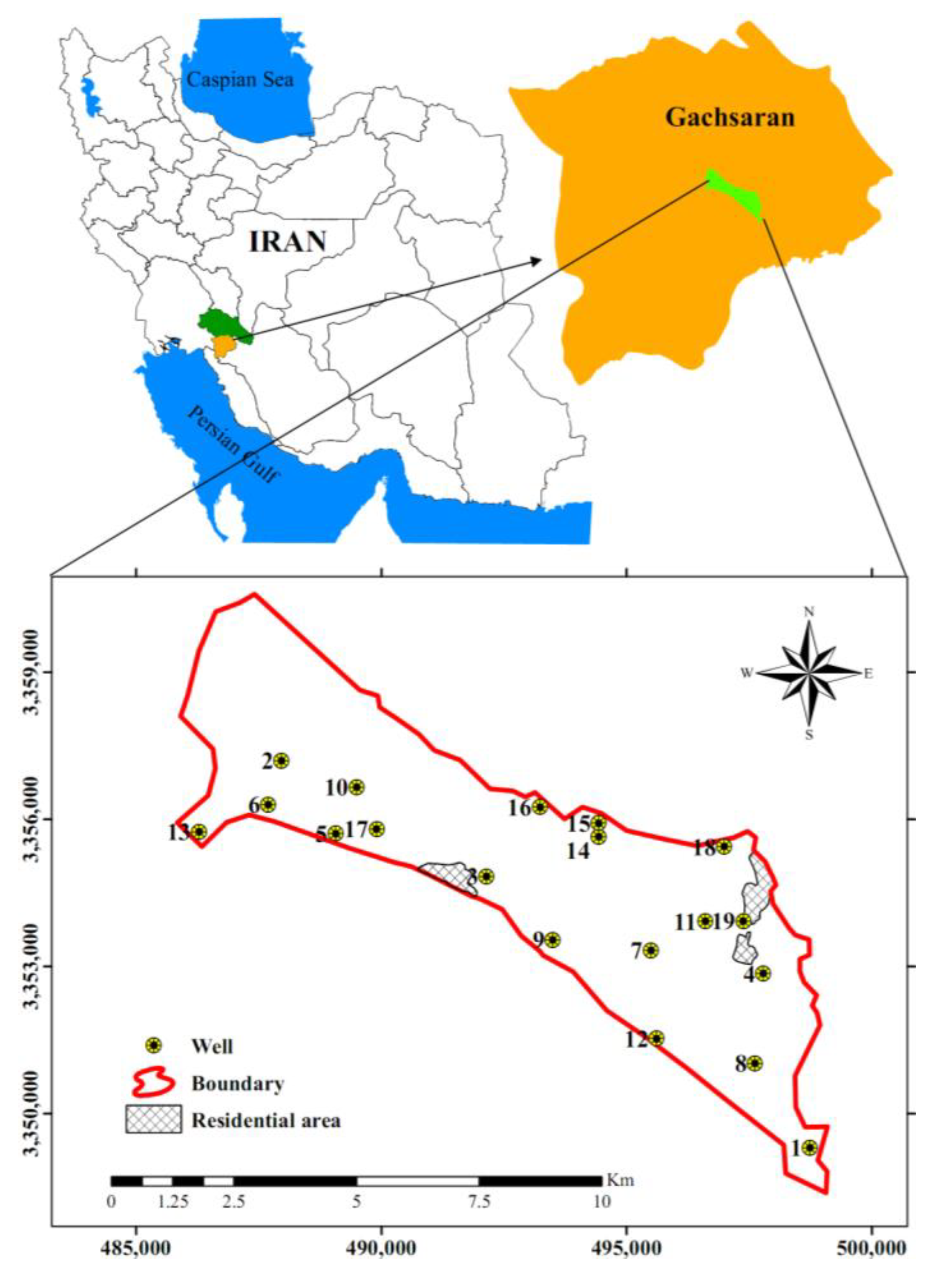
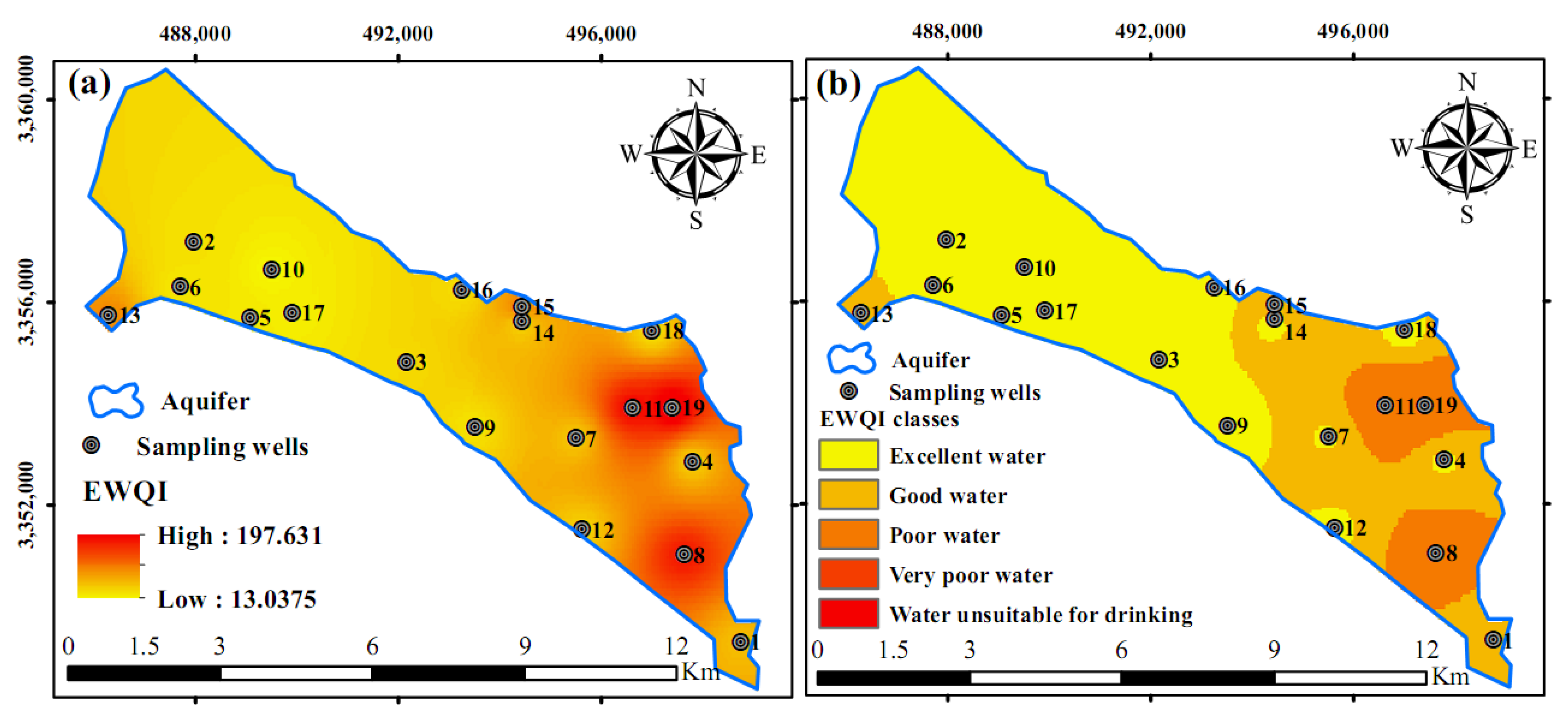
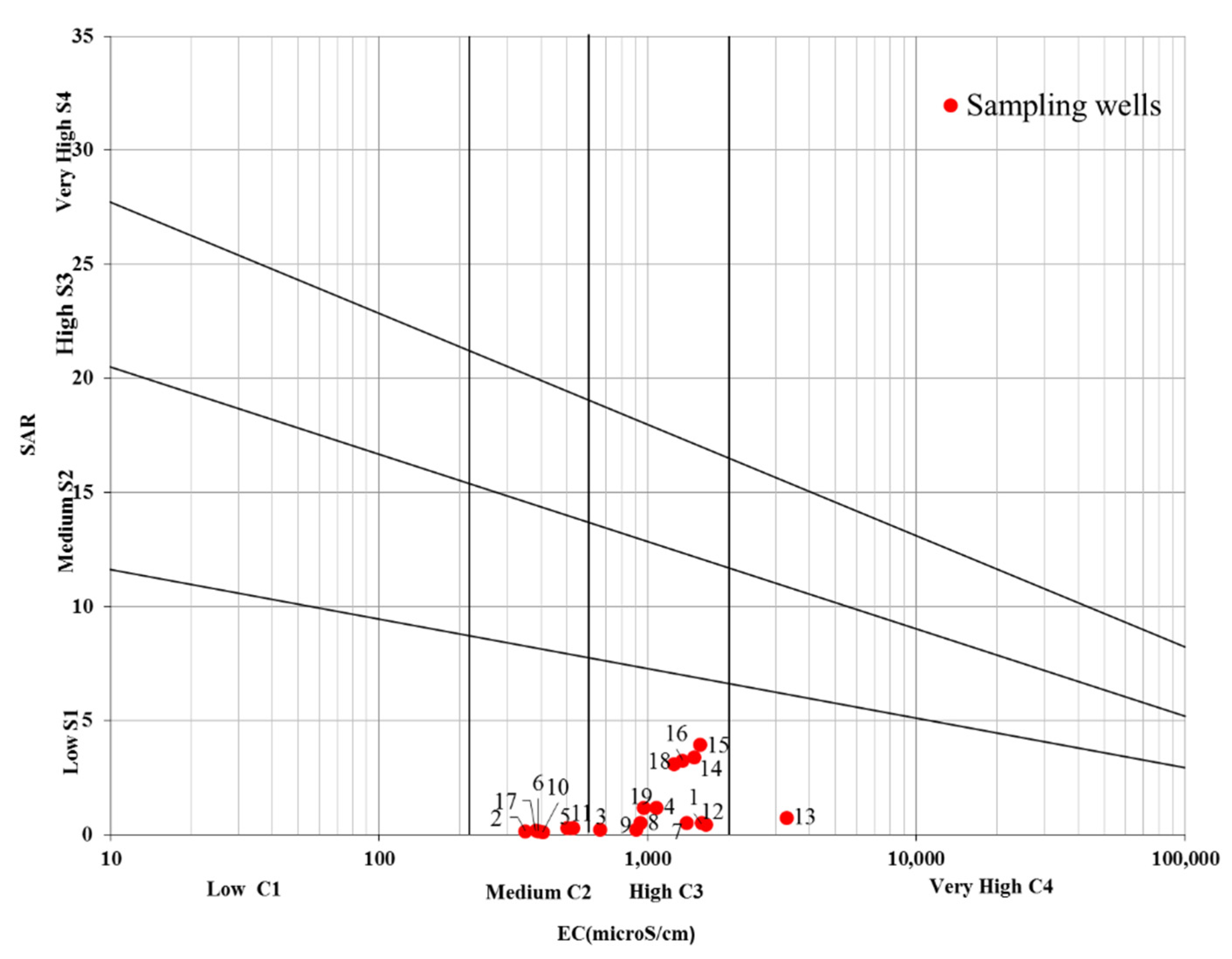
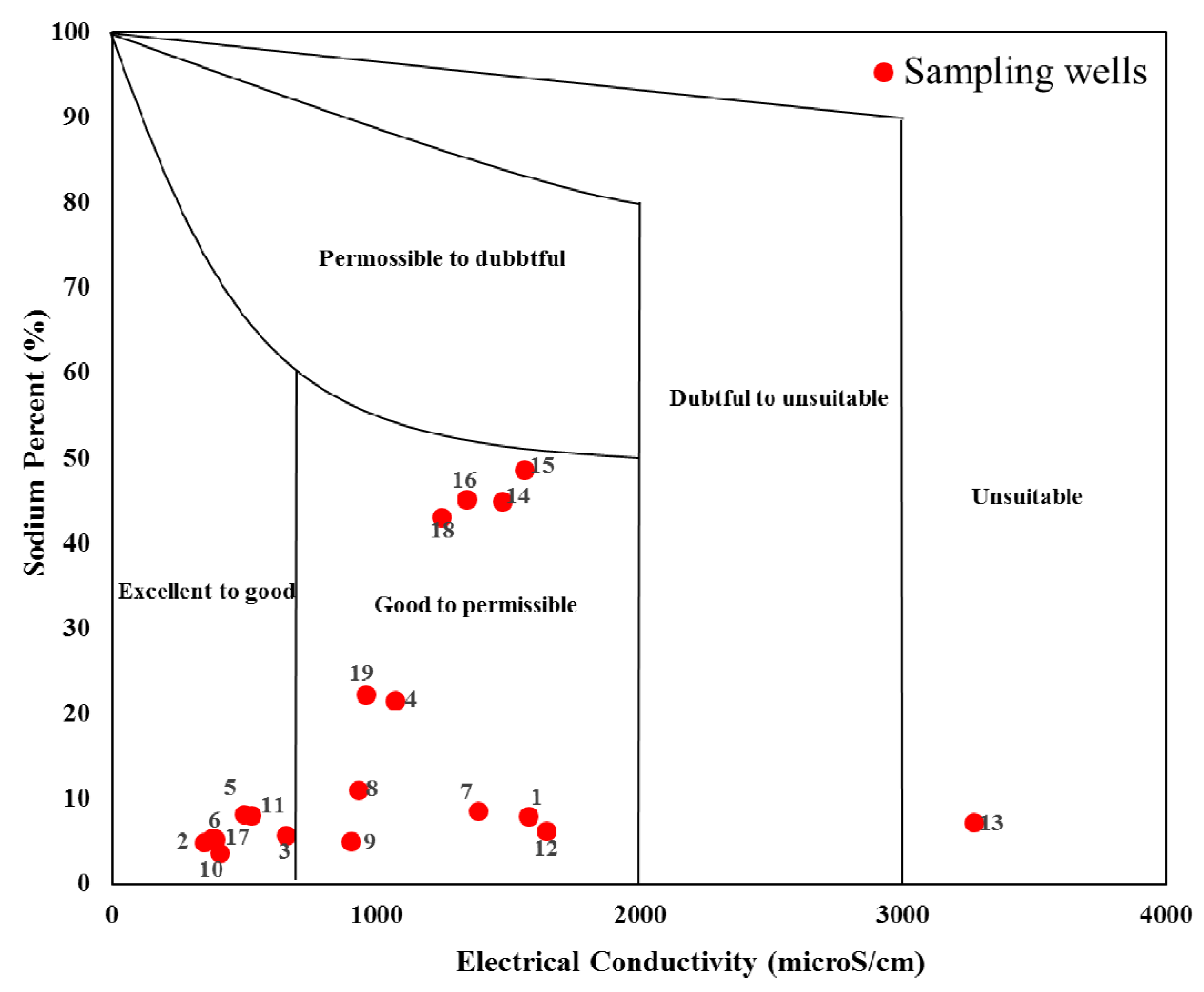
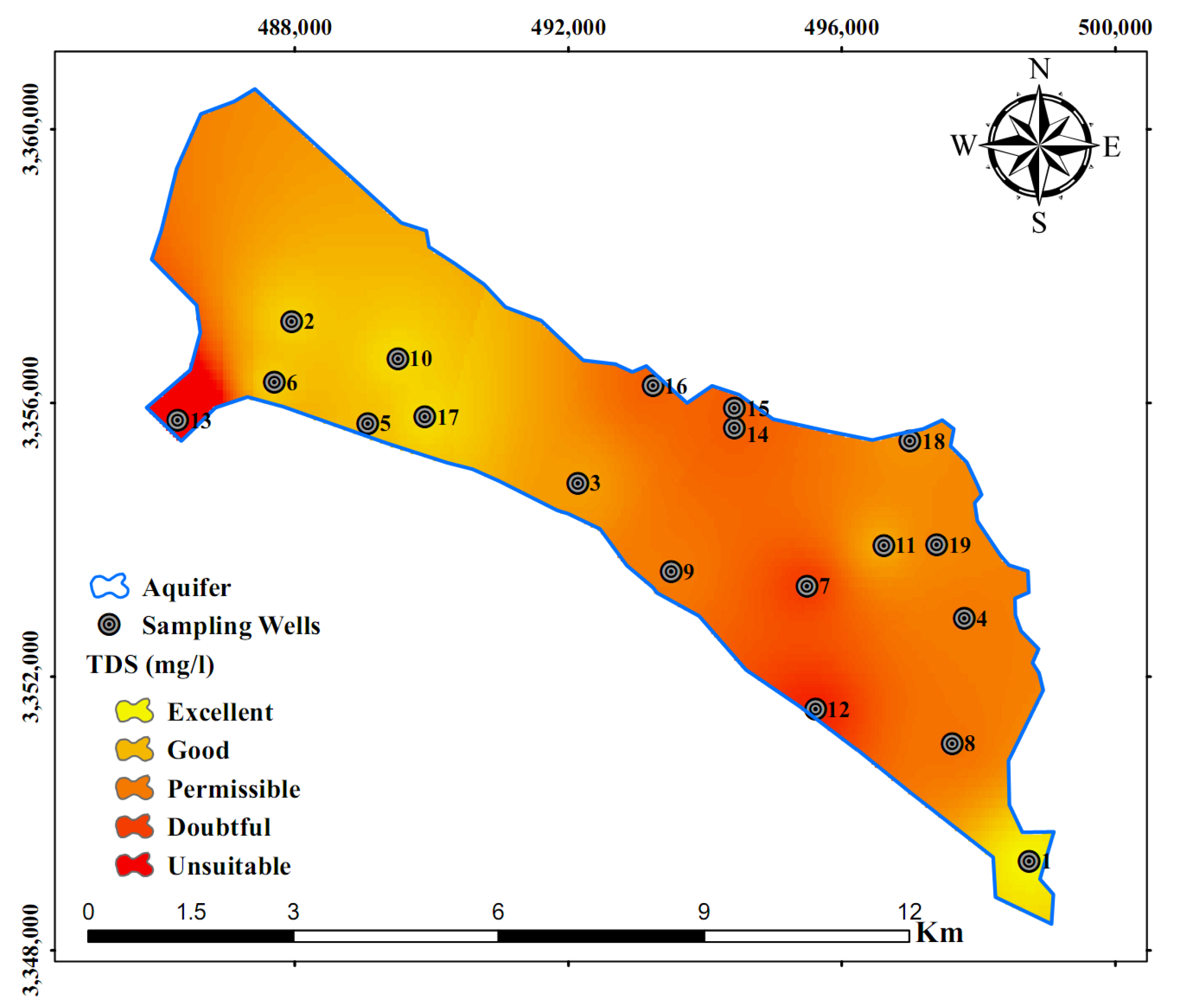
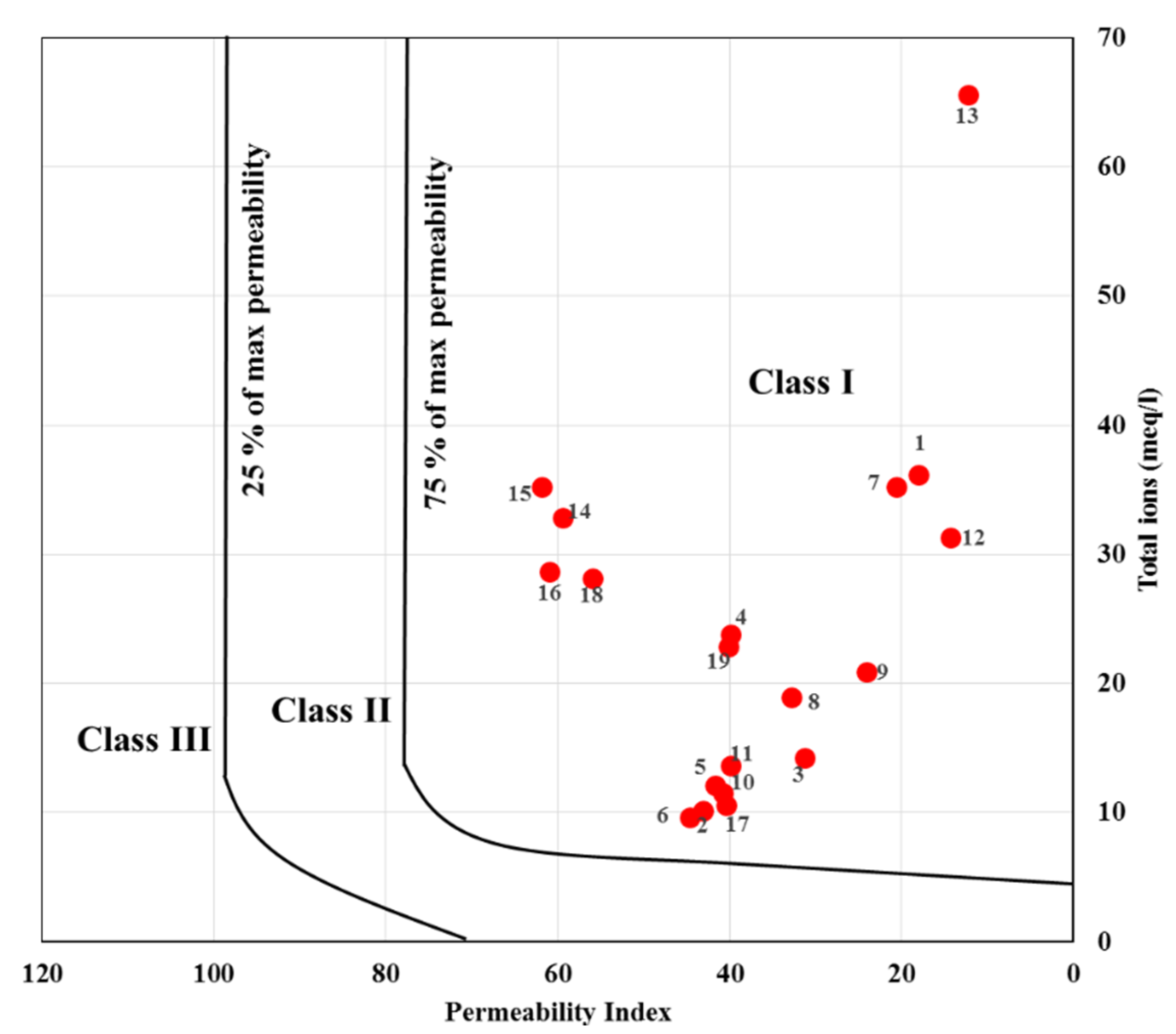
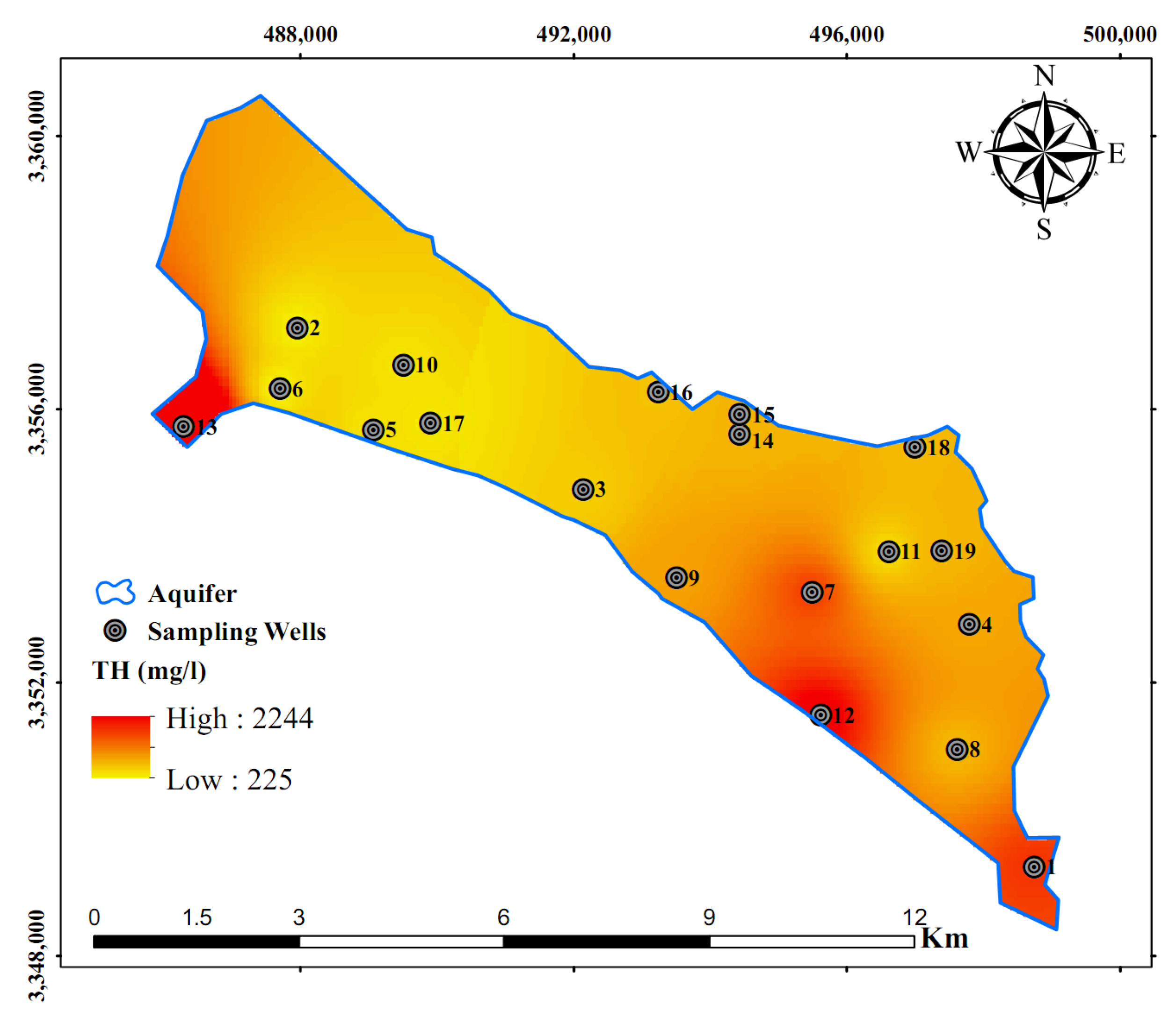
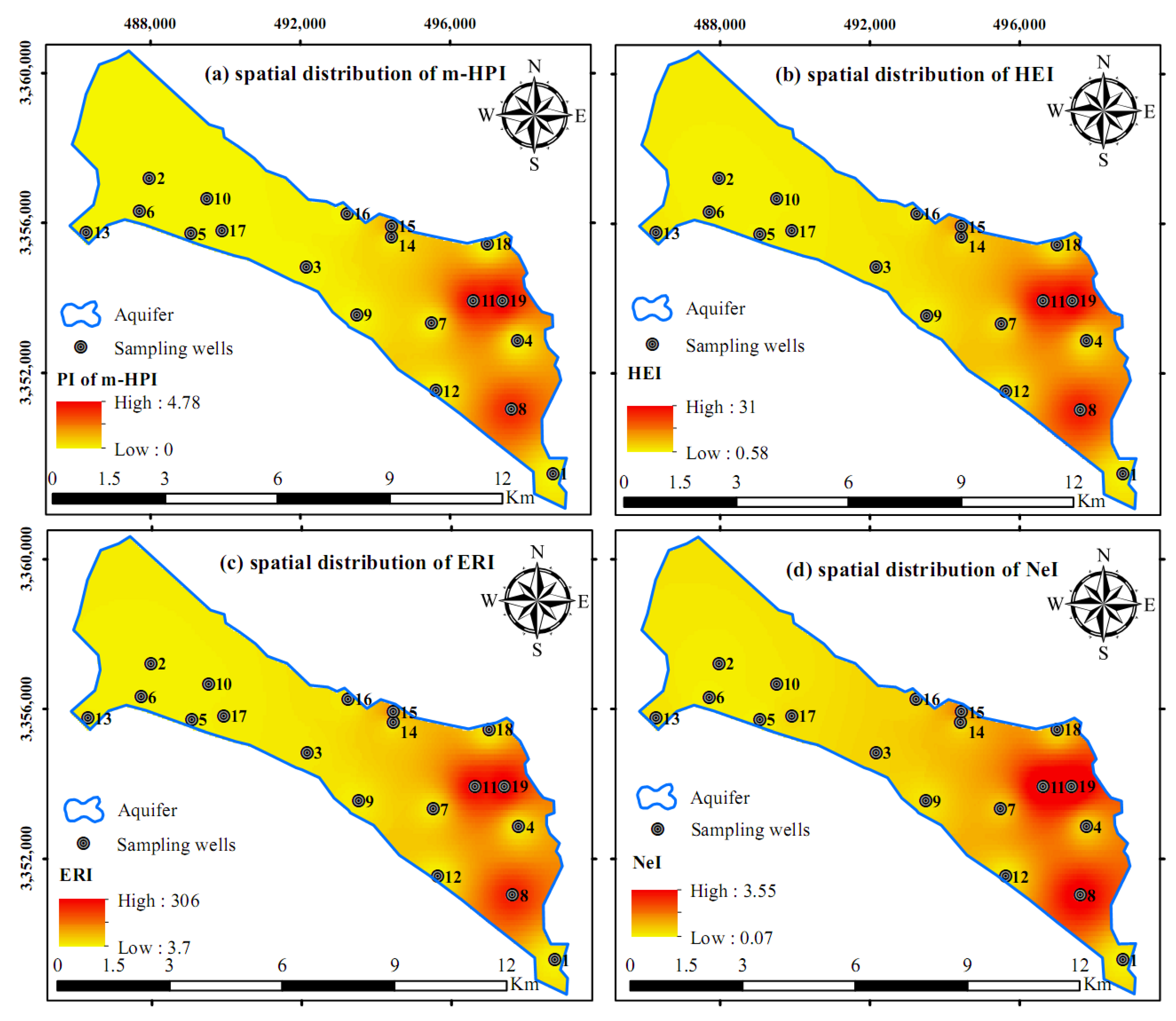

| Parameters | Unit | Analytical Method |
|---|---|---|
| Potassium | mg/L | Flame photometer |
| Sodium | mg/L | Flame photometer |
| Magnesium | mg/L | Titrimetric |
| Calcium | mg/L | Titrimetric |
| Sulfate | mg/L | Spectrophotometric |
| Chloride | mg/L | Titrimetric |
| Bicarbonate | mg/L | Titrimetric |
| pH | pH unit | pH meter |
| EC | µS/cm | Electrometric |
| Total dissolved solids | mg/L | Electrometric |
| Nitrate | mg/L | Spectrophotometric |
| Fluoride | mg/L | Spectrophotometric |
| Biochemical oxygen demand | mg/L | Dichromate method |
| Dissolved oxygen | mg/L | Winkler method |
| Chemical oxygen demand | mg/L | Winkler’s aside method |
| Arsenic | mg/L | Atomic Absorption Spectrophotometer |
| Cadmium | mg/L | Atomic Absorption Spectrophotometer |
| Antimony | mg/L | Atomic Absorption Spectrophotometer |
| Selenium | mg/L | Atomic Absorption Spectrophotometer |
| Zinc | mg/L | Atomic Absorption Spectrophotometer |
| Copper | mg/L | Atomic Absorption Spectrophotometer |
| Barium | mg/L | Atomic Absorption Spectrophotometer |
| Manganese | mg/L | Atomic Absorption Spectrophotometer |
| Chromium | mg/L | Atomic Absorption Spectrophotometer |
| Range | Type of Water |
|---|---|
| <50 | Excellent |
| 50–99.99 | Good |
| 100–199.99 | Poor |
| 200–299.99 | Very poor |
| >300 | Unsuitable for drinking |
| Parameters | Unit | Min | Max | Mean | SD | WHO Standard (2011) | Entropy Weight (Wi) |
|---|---|---|---|---|---|---|---|
| EC | µS/cm | 350 | 3270 | 1085 | 698.7 | 1500 | 0.01980 |
| pH | pH units | 7.01 | 7.68 | 7.36 | 0.18 | 6.5–8.5 | 0.00004 |
| TDS | mg/L | 165 | 3440 | 916.05 | 712.86 | 500 | 0.02545 |
| K+ | mg/L | 0.39 | 1.95 | 1.03 | 0.42 | 12 | 0.00835 |
| Na+ | mg/L | 4.83 | 190.21 | 54.90 | 60.88 | 200 | 0.05965 |
| Mg2+ | mg/L | 21.6 | 99.6 | 42.13 | 22.38 | 30 | 0.01288 |
| Ca2+ | mg/L | 52 | 732 | 150.32 | 156.72 | 75 | 0.03761 |
| HCO3− | mg/L | 213.5 | 359.9 | 259.09 | 41.54 | 300 | 0.00134 |
| Cl− | mg/L | 28.4 | 355 | 130.42 | 116.51 | 250 | 0.04106 |
| SO42− | mg/L | 12.96 | 453.12 | 140.93 | 126.97 | 250 | 0.03831 |
| NO3− | mg/L | 2 | 46 | 20.32 | 12.13 | 45 | 0.02167 |
| F− | mg/L | 0.55 | 1.41 | 0.80 | 0.21 | 1 | 0.00341 |
| BOD | mg/L | 0 | 7.8 | 1.89 | 2.70 | 5 | 0.10412 |
| COD | mg/L | 0 | 1.2 | 0.71 | 0.37 | 10 | 0.01681 |
| DO | mg/L | 2.5 | 7.1 | 4.96 | 1.10 | 5 | 0.00272 |
| As | µg/L | 4.6 | 15.0 | 7.9 | 4.0 | 100 | 0.01282 |
| Cd | µg/L | 0.3 | 303.6 | 50.1 | 103.5 | 30 | 0.17146 |
| Sb | µg/L | 10.6 | 223.7 | 96.6 | 75.0 | 200 | 0.03357 |
| Se | µg/L | 6.0 | 133.0 | 25.9 | 28.9 | 100 | 0.04521 |
| Zn | µg/L | 37.0 | 4060.0 | 559.1 | 1073.5 | 50,000 | 0.11664 |
| Cu | µg/L | 8.0 | 101.0 | 31.8 | 27.7 | 500 | 0.03329 |
| Ba | µg/L | 219.5 | 2436.5 | 983.5 | 699.8 | 7000 | 0.02528 |
| Mn | µg/L | 1.7 | 402.7 | 56.5 | 116.8 | 1000 | 0.13860 |
| Cr | µg/L | 6.0 | 138.0 | 33.7 | 29.0 | 500 | 0.02990 |
| Well Number | EWQI Value | Classification |
|---|---|---|
| 1 | 50.0 | Good water |
| 2 | 26.1 | Excellent water |
| 3 | 30.7 | Excellent water |
| 4 | 39.9 | Excellent water |
| 5 | 21.6 | Excellent water |
| 6 | 23.1 | Excellent water |
| 7 | 44.3 | Excellent water |
| 8 | 159.7 | Poor water |
| 9 | 24.9 | Excellent water |
| 10 | 13.0 | Excellent water |
| 11 | 172.5 | Poor water |
| 12 | 37.7 | Excellent water |
| 13 | 85.9 | Good water |
| 14 | 31.6 | Excellent water |
| 15 | 97.1 | Good water |
| 16 | 29.3 | Excellent water |
| 17 | 18.2 | Excellent water |
| 18 | 30.2 | Excellent water |
| 19 | 197.9 | Poor water |
| Well Number | m-HPI | PI | NI (m-HPI) | Classification | HEI | Classification | NeI | Classification | ERI | Classification |
|---|---|---|---|---|---|---|---|---|---|---|
| 1 | −0.92 | 0.000 | −0.92 | Excellent | 0.68 | Low | 0.07 | Insignificant | 5.94 | Low |
| 2 | −0.93 | 0.000 | −0.93 | Excellent | 0.83 | Low | 0.13 | Insignificant | 5.93 | Low |
| 3 | −0.86 | 0.009 | −0.87 | Very good | 1.62 | Low | 0.39 | Insignificant | 14.78 | Low |
| 4 | −0.84 | 0.003 | −0.84 | Very good | 1.74 | Low | 0.37 | Insignificant | 16.10 | Low |
| 5 | −0.95 | 0.000 | −0.95 | Excellent | 0.57 | Low | 0.08 | Insignificant | 4.33 | Low |
| 6 | −0.89 | 0.000 | −0.89 | Excellent | 0.88 | Low | 0.09 | Insignificant | 6.82 | Low |
| 7 | −0.67 | 0.052 | −0.73 | Very good | 2.61 | Low | 0.47 | Insignificant | 23.76 | Low |
| 8 | 3.31 | 3.692 | −0.38 | Unacceptable | 25.00 | High | 2.82 | Moderately | 248.49 | Considerable |
| 9 | −0.91 | 0.000 | −0.91 | Excellent | 1.02 | Low | 0.19 | Insignificant | 8.62 | Low |
| 10 | −0.93 | 0.000 | −0.93 | Excellent | 1.08 | Low | 0.19 | Insignificant | 7.83 | Low |
| 11 | 3.88 | 4.324 | −0.44 | Unacceptable | 28.07 | High | 3.25 | Moderate | 279.84 | Considerable |
| 12 | −0.91 | 0.000 | −0.91 | Excellent | 0.99 | Low | 0.12 | Insignificant | 7.34 | Low |
| 13 | −0.86 | 0.000 | −0.86 | Excellent | 1.95 | Low | 0.24 | Insignificant | 13.14 | Low |
| 14 | −0.88 | 0.000 | −0.88 | Excellent | 1.10 | Low | 0.16 | Insignificant | 9.90 | Low |
| 15 | 1.09 | 1.496 | −0.41 | Good | 12.13 | Medium | 1.35 | Slight | 120.32 | Moderate |
| 16 | −0.87 | 0.002 | −0.87 | Very good | 1.44 | Low | 0.36 | Insignificant | 13.35 | Low |
| 17 | −0.90 | 0.000 | −0.90 | Excellent | 1.66 | Low | 0.32 | Insignificant | 11.44 | Low |
| 18 | −0.83 | 0.002 | −0.83 | Very good | 1.69 | Low | 0.36 | Insignificant | 15.81 | Low |
| 19 | 4.38 | 4.787 | −0.41 | Unacceptable | 31.14 | High | 3.56 | Moderate | 308.54 | Considerable |
© 2020 by the authors. Licensee MDPI, Basel, Switzerland. This article is an open access article distributed under the terms and conditions of the Creative Commons Attribution (CC BY) license (http://creativecommons.org/licenses/by/4.0/).
Share and Cite
Maskooni, E.K.; Naseri-Rad, M.; Berndtsson, R.; Nakagawa, K. Use of Heavy Metal Content and Modified Water Quality Index to Assess Groundwater Quality in a Semiarid Area. Water 2020, 12, 1115. https://doi.org/10.3390/w12041115
Maskooni EK, Naseri-Rad M, Berndtsson R, Nakagawa K. Use of Heavy Metal Content and Modified Water Quality Index to Assess Groundwater Quality in a Semiarid Area. Water. 2020; 12(4):1115. https://doi.org/10.3390/w12041115
Chicago/Turabian StyleMaskooni, Ehsan Kamali, Mehran Naseri-Rad, Ronny Berndtsson, and Kei Nakagawa. 2020. "Use of Heavy Metal Content and Modified Water Quality Index to Assess Groundwater Quality in a Semiarid Area" Water 12, no. 4: 1115. https://doi.org/10.3390/w12041115
APA StyleMaskooni, E. K., Naseri-Rad, M., Berndtsson, R., & Nakagawa, K. (2020). Use of Heavy Metal Content and Modified Water Quality Index to Assess Groundwater Quality in a Semiarid Area. Water, 12(4), 1115. https://doi.org/10.3390/w12041115







